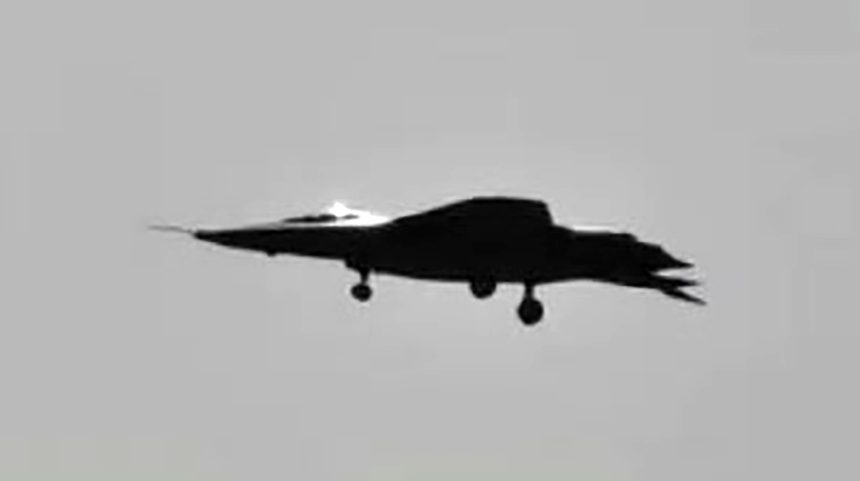New photo from recent flight offers clearest view yet of the stealth aircraft’s profile, providing fresh insights into its cockpit configuration.
New photos that surfaced online on Apr. 16, 2025, provide the best side view yet of the mysterious new aircraft developed by the Shenyang Aircraft Corporation (SAC). As previously reported, the prototype is believed to be designated J-XDS or J-50 although it’s important to note these names remain speculative, with no official confirmation from Chinese authorities regarding the aircraft’s designation or intended role.
This stealth fighter represents the second newly unveiled design to appear since Dec. 26, 2024, the other being the larger J-36, developed by Chengdu Aircraft Corporation (CAC).
The latest imagery, shot during some of the most recent test flights, offers the most detailed look to date at the profile of the J-XDS, a tailless configuration with a lambda wing (a design known for its aerodynamic efficiency and low radar cross-section), that also features twin engines, Diverterless Supersonic Inlets (DSI), and what may be 2D thrust-vectoring nozzles, all of which enhance both maneuverability and stealth performance.
Of particular interest, the most recent side images confirm the presence of a canopy, providing the clearest evidence yet that the aircraft is manned, despite earlier speculation suggesting it could be unmanned. While some defense analysts have floated the possibility of an uncrewed or dual-mode configuration, reflecting trends in sixth-generation fighter development, the clear visibility of the cockpit in the new images reinforces the idea that the current prototype is designed for human operation.
As it seems, we finally have a quite decent side shot of SAC’s J-XDS from its flight today and also for the first time a clearer proof it has indeed a canopy. pic.twitter.com/i0IEmLebYH
— @Rupprecht_A (@RupprechtDeino) April 16, 2025
Compared to a conventional trapezoidal wing—such as that seen on the Shenyang J-35—the lambda wing provides a higher aspect ratio and improved aerodynamic performance while maintaining stealth characteristics. That said, the design’s broken trailing edge introduces structural trade-offs, including reduced efficiency and additional weight.
Also Today – AI Enhanced • J-50(?) https://t.co/HL8GEzVo8d pic.twitter.com/Lf1shOVtyN
— David Wang (@Nickatgreat1220) April 16, 2025
As in all previous footage and photos, the aircraft is shown on its landing gear in a tricycle configuration, with twin wheels on the nose gear. While prior reports have suggested the J-XDS may incorporate both ventral and side-mounted weapon bays, the latest images, just like the previous ones, aren’t sharp enough to confirm any panel lines or payload configurations, despite the enhancement with AI.
As it seems, SAC’s J-XDS was seen again or at least a previously not yet released image – and IMO the clearest so far! – was posted.
… and I must admit, the more I see, the more I love it! 🥰
(Image via @Captain小潇 from Weibo) pic.twitter.com/BAm73MeoQr
— @Rupprecht_A (@RupprechtDeino) April 15, 2025
As explained, one of the photos circulated online in the last weeks, appears to support claims that the wingtips may be movable. The right wingtip seems to pivot around a central point, suggesting swiveling outer wing sections that could function as major flight control surfaces. These would enable enhanced roll control, and possibly pitch control when working in tandem, compensating for the aerodynamic challenges typically associated with a tailless design. Paired with a digital flight control system, this configuration could contribute to both high agility and overall flight stability.
Visibility as Strategy
The growing number of sightings and leaked imagery of China’s next-generation platforms, such as the J-XDS and J-36 stealth fighters, may reflect a broader strategic shift. Beijing appears to be deliberately allowing greater visibility into its advanced military programs, a move that aligns with escalating tensions between China and the United States.
These developments come amid renewed trade frictions, with former President Donald Trump reinstating and expanding tariffs on Chinese imports in early 2025, citing concerns over fentanyl trafficking and persistent trade imbalances. In response, China has imposed retaliatory tariffs on U.S. goods, restricted exports of critical rare earth elements, and launched investigations into American companies. The tit-for-tat measures have further strained bilateral relations and triggered uncertainty in global markets, raising fears of supply chain disruptions and an economic slowdown.
Against this backdrop, Beijing’s increased military transparency may serve as a calculated signal of its technological maturity and strategic resolve, intended to assert China’s position on the global stage amidst growing geopolitical and economic pressure.









